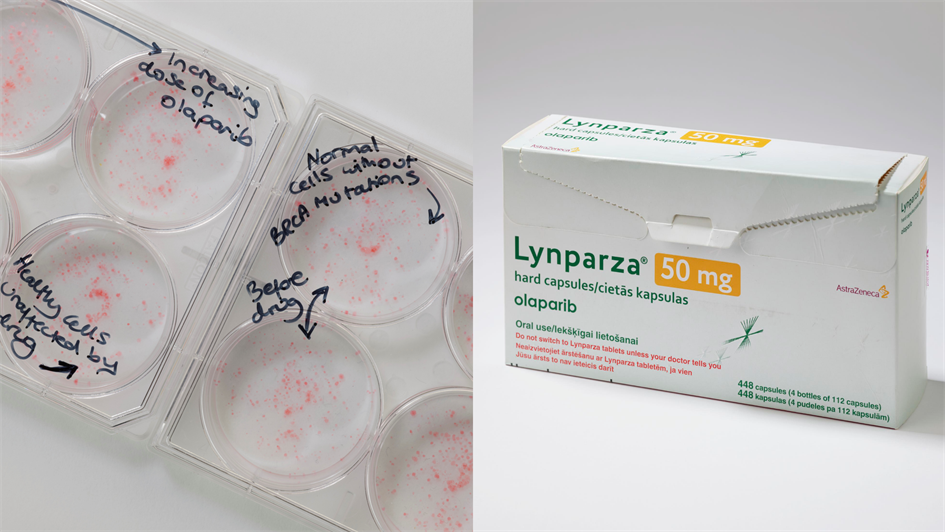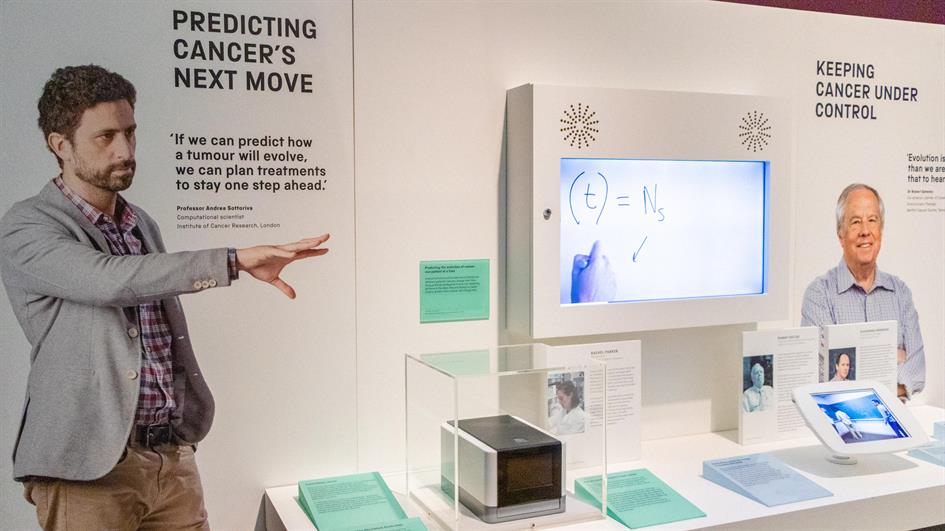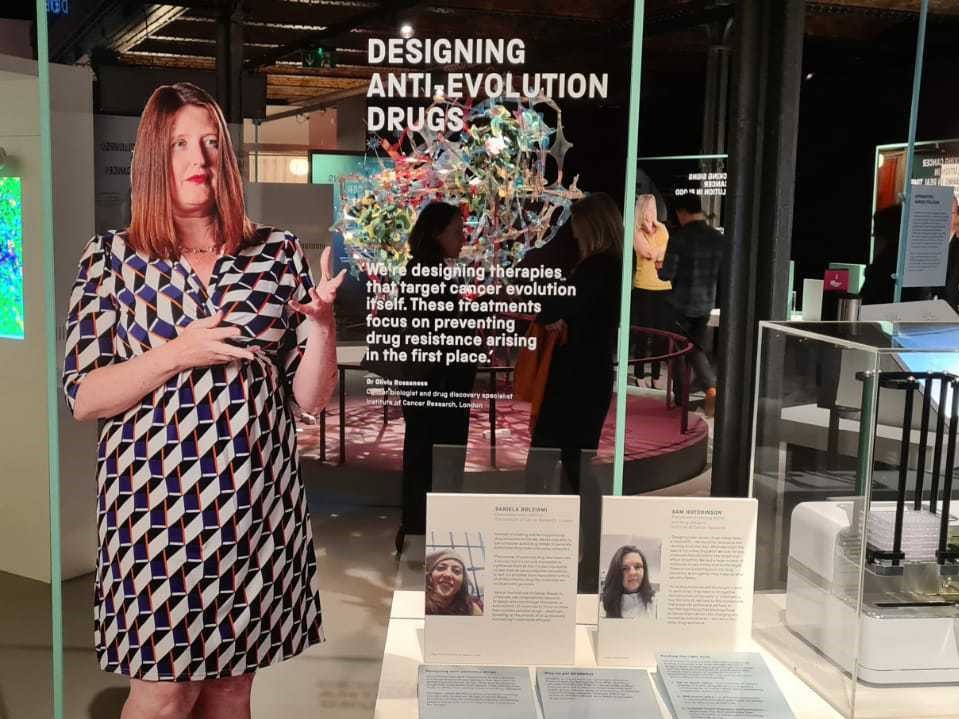
Image: An exhibit featuring our research into APOBEC inhibitors and the scientists behind it, including Dr Olivia Rossanese, Head of the Division of Cancer Therapeutics and Director of the Cancer Therapeutics Unit, Dr Daniela Dolciami and Dr Sam Hutchinson.
A new, free exhibition chronicling how science is transforming cancer care opens at the Science Museum in London today – featuring discoveries led by researchers at The Institute of Cancer Research, London.
Cancer Revolution: Science, innovation and hope is the world’s first major exhibition to reveal the past, present and future of how cancer is prevented, detected and treated. The exhibition opens at Science Museum after a successful run at Manchester's Science and Industry Museum.
The past, present and future of cancer research
Through more than 100 objects and personal accounts, the exhibition brings to life the stories of people affected by cancer, together with those who study and treat it. The exhibition uses ICR research to help tell this story of scientific progress from breakthroughs of the last few decades that have already transformed cancer treatment, to our cutting-edge research seeking to understand and overcome cancer evolution.
The exhibition was created by the Science Museum Group with support from expert partner Cancer Research UK, and developed alongside an expert advisory board which included the ICR’s former Chief Executive, Professor Paul Workman.
To launch the exhibition, we will also have three lab coats embroidered with messages from patients and their families on display as part of the Lates, a monthly themed evening opening exclusively for adults, on 25 May.
The revolution in cancer care

Image: Objects donated by the ICR to the exhibition. Left: Plates showing the impact of olaparib on BRCA cancer cells and minimal impact of on healthy cells. (Right) Lynparza, olaparib’s brand name, drug packaging. Credit: Science Museum Group.

This section shares an account from Professor Chris Lord, Deputy Head of the Breast Cancer Research Division and the leader of the CRUK Gene Function Team, who helped lead this research.
One of the scientific achievements highlighted in the exhibition is our research underpinning the development of targeted drug olaparib, which is now transforming the lives of patients with ovarian, breast and prostate cancer.
Our researchers found that targeting a DNA repair protein called PARP was a potential way to kill cancer cells with a faulty BRCA gene. This helped lead to the development of olaparib. In 2014, it became the first of a new class of targeted drugs, called PARP inhibitors, approved to treat cancer patients with BRCA gene mutations.
Outsmarting cancer evolution

Image: A display showing former ICR Professor Andrea Sottoriva in a section highlighting our research on cancer evolution is included in the exhibition.
The exhibition also features how our researchers are leading the way in understanding how cancer evolves and developing new treatments to outsmart cancer.
The exhibition highlights our work to develop the world's first family of drugs to specifically target cancer's ability to evolve and become resistant to treatment. These potential drugs are being designed to stop the action of a molecule called APOBEC to reduce the rate of mutation in cancer cells, slow down evolution and delay resistance.
APOBEC protein molecules are crucial to the ability of the immune system to adapt to different infectious diseases – but are also hijacked in over half of cancer types to speed up evolution of drug resistance.
Researchers hope that a new class of APOBEC inhibitors could be given alongside a targeted cancer treatment to ensure it can keep cancer at bay for much longer.
Cancer can adapt and evolve to evade treatment. We are looking for new ways to stay one-step-ahead of cancer and using treatments in combination is one way of doing this. Support our research today to unlock new combination therapies, and help more people survive cancer.
Let’s finish cancer, together.
Lab coats tell patients’ stories
On display for just one night to launch the exhibit as part of a special cancer-themed Lates will be three unique works of ‘wearable art’ created using our scientists’ lab coats.
Leading British textile artist Rosalind Wyatt transformed our lab coats into powerful and moving artworks emblazoned with intricately hand-stitched words and drawings provided by patients and their families with rare and hard-to-treat cancers. The artist and some of the patients and their families will also be in attendance for the artwork’s first public display.
Visitors will be invited to share their own messages to cancer to hang alongside the lab coats. After the Lates, the lab coats will return to their permanent display in the windows of the ICR’s Chester Beatty Labs nearby in Chelsea where our scientists are working to make the discoveries to defeat cancer.
A proud showcase of our research
Professor Kristian Helin, Chief Executive of the ICR, said:
"I am thrilled that the Cancer Revolution exhibition opens at the Science Museum today - telling the story of how science is transforming the lives of cancer patients. I'm proud that it includes so much of the ICR's research, from our discovery of how to genetically target PARP inhibitor drugs, to our work to create new anti-evolution cancer treatments. I am grateful to all those who have been involved in pulling this world-first exhibition together, and hope it helps to reinforce public support for cancer research."
The exhibition was made possible by funding from Cancer Research UK, Pfizer, John S Cohen Foundation and Julian Howard.
Cancer Revolution: Science, innovation and hope runs at the Science Museum in London until January 2023. Tickets are free but booking is required.
